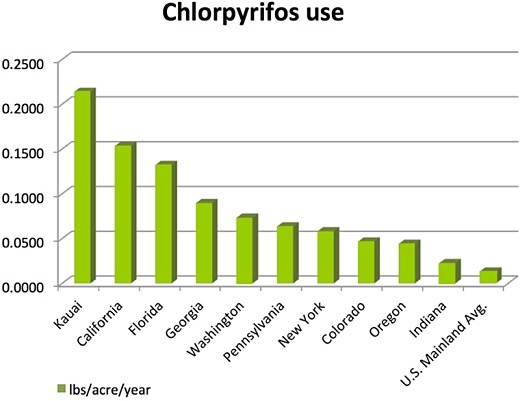SUBHEAD: Atrazine and Chlorpyrifos are dangerous restricted use pesticides heavily used on Kauai.
By Dr. Lee Evslin on 3 Monday 2016 for the Garden Island -
(http://thegardenisland.com/news/opinion/guest/of-kauai-s-pesticides-are-having-a-bad-year/article_f419ec77-6e03-5c44-92c9-b23264b28a97.html)

Image above: Waimea, Kauai in foreground adjacent to hundreds of pesticide soaked acres experimental GMO crops. Waimea Middle School's yard faces the fields. Children have gotten sick there. From (https://www.theguardian.com/us-news/2015/aug/23/hawaii-birth-defects-pesticides-gmo).
Atrazine and Chlorpyrifos are two of the most heavily sprayed restricted use (RUPs) pesticides on Kauai. In the past year they have come under increasing fire from specialists in pediatric neurology, the EPA, U.S. Fish and Wildlife Service (USFWS), and the National Marine Fisheries Service (NMFS).
- On Oct. 30 2015, the EPA recommended the prohibition of Chlorpyrifos for agricultural use in the U.S. They stated that it was risky for workers and it was found to contaminate surface waters. Chlorpyrifos is the chemical that led to the symptoms experienced by the Syngenta workers. This recommendation for prohibition is still under review.
- In April 2016, the European Union did prohibit Chlorpyrifos for agricultural use in all 29 countries. They did this with very little advance notice, stating that they acted rapidly due to health concerns.
- In April 2016, the EPA released a statement drawn up with consultation with the Fish and Wildlife and Marine Fisheries Services. They stated that after reviewing 1400 studies they concluded that Chlorpyrifos was “likely to adversely affect” 97 percent of endangered species both on the land and in the water.
- In July 2016, Project TENDR released a position paper. Leading experts in neurologic development and in related fields created this document. They stated that there is an alarming national increase in neurobehavioral disorders in children and increasing evidence that environmental toxins were playing a role. Pesticides were first in their list of these toxins and Chlorpyrifos is a prominent chemical in the studies they reviewed.
- In April 2016, the EPA released a position paper on Atrazine. They stated that after reviewing hundreds of studies they concluded that at currently allowable levels of spraying, Atrazine was likely to exceed safe levels of exposure for land and sea animals. The EPA stated their “levels of concern for chronic risk are exceeded by as much as 22, 198 and 62 times for birds, mammals and fish, respectively.” Of note also is that Atrazine has been prohibited in Europe for decades.
The EPA is being very clear about their increasing concern about both of these chemicals. I can only speak for myself but my concern about the possible effect of these chemicals on human health and on the environment has increased also.
• Dr. Lee Evslin is a retired physician. He has lived and practiced on Kauai since 1979. He also served as the CEO of Kauai Medical Clinic and Wilcox Hospital.

Image above: Graph showing the highest concentration per acre of Chlorpyrios on agricultural fields are on the small island of Kauai. More than ten times the US mailand average. From (http://grist.org/business-technology/gmo-companies-are-dousing-hawaiian-island-with-toxic-pesticides/).
[IB Publisher's Note: In addition a study published by the National Institute of Health in 2014 titled "Effects of atrazine and chlorpyrifos on DNA methylation in the liver, kidney and gill of the common carp" demonstrated that long-term exposure to Atrazine and Chlorpyrifos or Atrazine/Chlorpyrifos mixtures could disrupt genomic DNA."]
.
No comments :
Post a Comment